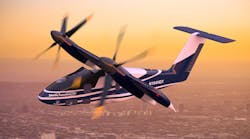Sikorsky announced a plan to build, test, and fly a hybrid-electric vertical takeoff and landing aircraft with a tilt-wing configuration, the first of a series of HEX/VTOLs that the Lockheed Martin subsidiary intends to develop with different degrees of electrification plus autonomous capabilities.
The Sikorsky hybrid-electric (HEX) development program will prioritize designs for aircraft with greater-than-500-nautical-mile range at high speed, as well as fewer mechanical systems in order to reduce design complexity and maintenance costs.
“Autonomy and electrification will bring transformational change to flight safety and operational efficiency of large VTOL aircraft,” stated Sikorsky president Paul Lemmo. “Our HEX demonstrator program will provide valuable insights as we look to a future family of aircraft built to the scale and preferred configurations relevant to commercial and military customers.”
The company’s prototyping group, called Sikorsky Innovations, is working with GE Aerospace to build a hybrid-electric power systems testbed with a 600-kW electric motor. Sikorsky Innovations was formed in 2010 to develop technologies that improve rotary wing speed and apply autonomy and intelligence to VTOL aircraft.
The testbed will be used to evaluate hover performance of the HEX demonstrator — a 9,000-lbs. maximum gross weight aircraft with 1.2-MW-class turbogenerator and associated power electronics.
“Within Sikorsky’s electric pillar, we are designing electric motors, power electronics, and our own vehicle management hardware and actuation,” stated Igor Cherepinsky, Sikorsky Innovations director. HEX will integrate these components, showcase the growing maturity of our MATRIX™ autonomy suite, and the potential for maintenance-free systems. Seeing the results will lead us to more efficient overall designs.”






